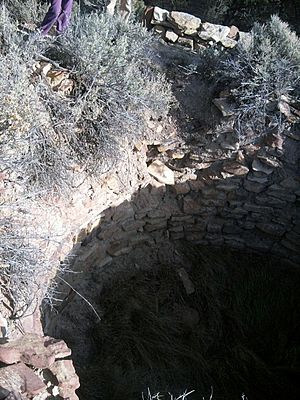Gallina facts for kids
The Gallina culture was a group of people who lived in what is now north-central New Mexico. They lived there long before Europeans arrived, from about 1050 to 1300. Their culture is named after the Rio Gallina (Gallina River) and Largo Canyon, where they made their homes. The Gallina people lived north of the Jemez Mountains.
Contents
Tools and Daily Objects
It can be tricky for archaeologists to figure out what some Gallina objects were used for. Sometimes, an object that looked like a scraper was actually a knife! To understand these items, experts look at how they were made and how they show signs of use.
Common objects found at Gallina sites include pots and jars. It seems the Gallina people were also very good at basket weaving. They might have traded local stones like Jemez Mountain Obsidian and Pedernal Chert with other groups.
Gallina Pottery Styles
Some of the pottery made by the Gallina people looked similar to another style called Rosa. However, Gallina pottery had its own special features. For example, they made wide-mouthed cooking pots, which are not found in Rosa sites.
Also, most Rosa jars had flat bottoms. But many Gallina jars had a pointed bottom that tapered down. This design probably helped them stand upright in a bed of ashes in a fire pit. The Gallina also shaped the necks of their jars to make them easier to hold. They are also known for their black-on-white pottery designs. These patterns were more detailed than those found in Rosa pottery.
Gallina Homes and Buildings
The Gallina people's building styles were also influenced by the Rosa culture. Their villages usually had between three and twenty homes. These homes were a mix of surface buildings and pit houses. They were often built facing north and south.
Pit houses were often dug into the highest parts of mesas and sometimes surrounded by a palisade (a fence of strong posts). Surface houses often had storage areas built off their east and west sides. These homes were usually "unit-type" houses, built with thick walls of natural stones held together with mud mortar. The inside walls were smooth and neatly plastered.
Their homes had fire pits with U-shaped deflectors. These helped direct heat and catch ash. There was usually a ventilation shaft through the wall, following the north-south direction of the house. The roofs inside were made of beams, and bags were hung from them for storage. Surface houses were always rectangular. However, pit houses could be round or rectangular. Tunnels sometimes connected pit houses to surface houses. The Gallina people might have moved their homes short distances, perhaps to follow rainfall.
Mystery Towers
The Gallina people built masonry towers along ridges. These towers had thick walls and were very well-built. The thick walls likely helped support their weight. The towers were not designed to have two stories. People usually entered them from a high level using a ladder.
These towers might have been signal stations, like a line of old-fashioned telegraph stations. Another idea is that the towers were simply used to store food that wasn't eaten right away.
Life During Droughts
Around 1161, the weather in the region started to get much drier, leading to drought conditions. Not every year was bad, but the overall pattern was increasingly dry. From 1250 to 1265, the drought was especially severe. The years 1278 and 1292 were the worst. The drought really started to impact their crops from 1171 to 1296. Scientists know about these droughts by studying tree rings, a method called Dendrochronology.
Mountain Camps
During the difficult drought times, some Gallina people left their villages. They went to camp on Canjilón Mountain to hunt and gather food. These mountain camps usually had two to ten people. They brought essential items like a cook pot, water jar, food bowl, and canteen. They didn't make pottery at these camps.
Archaeologists believe these camps were mostly for hunting, because they found many arrows, knives, and scrapers there. The camps were often located on lava beds. Lava rocks hold and release the sun's heat, which might have made small areas warm enough for farming, though this is still debated. Flat pieces of lava were used as shared workspaces and for drying meat and plants. Paths led to these homes and drying areas. Sometimes, these paths were "paved" with rock slabs or filled with small stones.
Why Did the Gallina Culture End?
Most Gallina sites that have been found look like they were left in a very organized way. Fire pits were filled, and floors were cleaned. The houses were quickly burned, and then the roof timbers were removed. Some archaeologists think this was done on purpose, perhaps to prevent others from using personal items left behind.
There is some evidence that the Gallina people might have started to move away around 1275, shifting towards the northern part of the Jemez area. However, there is also evidence that the Gallina might not have left willingly. Almost every Gallina skeleton found shows signs of violence. Broken necks are common, and the skeletons rarely look like they were properly buried.
Archaeologists have also found remains of Gallina people who were killed, thrown into their homes, and then their homes were burned. Some victims were even found in the towers. The reason for these deaths is still debated. Some ideas include widespread conflict or fighting among different groups. The long drought could have made these conflicts worse. Research is still ongoing to find out what truly happened.



